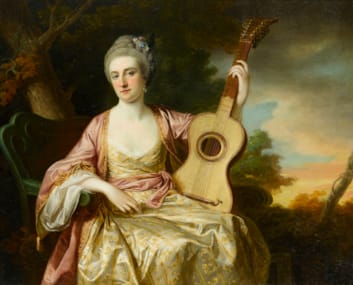
rancis Cotes, R.A.
(London 1726 - Richmond 1770)
 Biography
Biography Portrait of Maria Walpole, Countess Waldegrave, Later H.R.H. Duchess of Gloucester and Edinburgh (1736-1807)
Biography
Francis Cotes was born in London, the eldest son of Robert Cotes, an apothecary. He first made his mark as a pastellist in 1748. He trained with the portrait painter George Knapton (1698–1778) before setting up his own studio in his father's business premises in Cork Street, London. Cotes used brighter colours than his master and his work displayed the influence of Rosalba Carriera (1675-1757) and Jean-Etienne Liotard (1702-1789). His preferred media were pencil and pastels, in the making of which the knowledge of chemistry he gained in his father’s shop was of some assistance. During the 1760s however, Cotes turned his attention to oil painting, and adopted Reynold’s (1723-1792) portrait style, in contrast to Knapton’s more conservative work. He became Reynold’s most serious competitor before the arrival of Thomas Gainsborough (1727-1788) in London, after Cotes’ premature death.
In 1763, Cotes bought a large house and studio in Cavendish Square, later occupied by George Romney (1734-1802).
One of the most fashionable portrait painters of his day, Cotes helped found the Society of Artists and became its director in 1765. At the peak of his popularity, Cotes was invited to become one of the first members of the Royal Academy, but died just two years later, aged 44, in Richmond.
He taught pastel painting to John Russell (1745-1806), and his skills were described in Russell's book The Elements of Painting with Crayon (1772).
Francis Cotes' younger brother Samuel (1734–1818) also became an artist, specialising in miniatures.
Collections:
Francis Cotes is represented in the following collections, among others: the Royal College, Cardiff; National Portrait Gallery, Edinburgh; National Portrait Gallery, London; Tate, London; Royal Academy, London; Coram Foundation, London; Christchurch College, Oxford...









